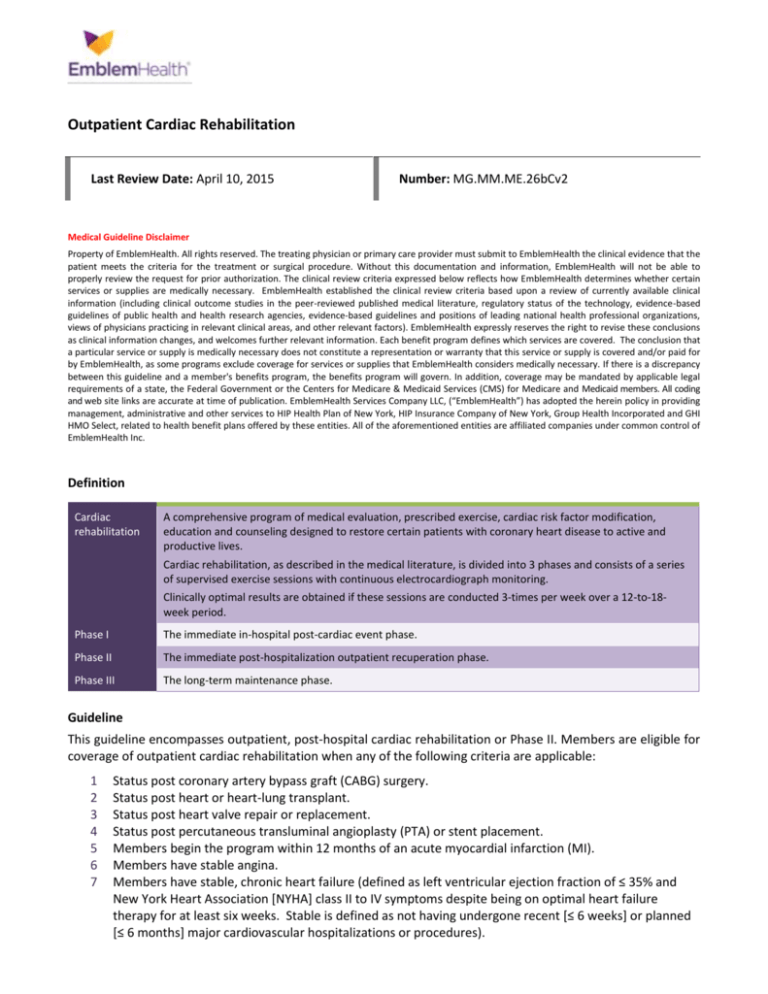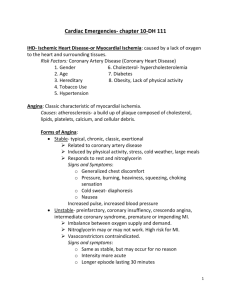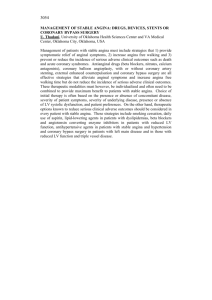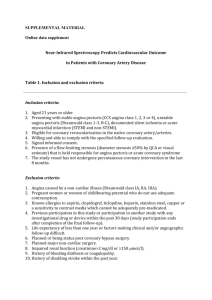
Outpatient Cardiac Rehabilitation
Last Review Date: April 10, 2015
Number: MG.MM.ME.26bCv2
Medical Guideline Disclaimer
Property of EmblemHealth. All rights reserved. The treating physician or primary care provider must submit to EmblemHealth the clinical evidence that the
patient meets the criteria for the treatment or surgical procedure. Without this documentation and information, EmblemHealth will not be able to
properly review the request for prior authorization. The clinical review criteria expressed below reflects how EmblemHealth determines whether certain
services or supplies are medically necessary. EmblemHealth established the clinical review criteria based upon a review of currently available clinical
information (including clinical outcome studies in the peer-reviewed published medical literature, regulatory status of the technology, evidence-based
guidelines of public health and health research agencies, evidence-based guidelines and positions of leading national health professional organizations,
views of physicians practicing in relevant clinical areas, and other relevant factors). EmblemHealth expressly reserves the right to revise these conclusions
as clinical information changes, and welcomes further relevant information. Each benefit program defines which services are covered. The conclusion that
a particular service or supply is medically necessary does not constitute a representation or warranty that this service or supply is covered and/or paid for
by EmblemHealth, as some programs exclude coverage for services or supplies that EmblemHealth considers medically necessary. If there is a discrepancy
between this guideline and a member's benefits program, the benefits program will govern. In addition, coverage may be mandated by applicable legal
requirements of a state, the Federal Government or the Centers for Medicare & Medicaid Services (CMS) for Medicare and Medicaid members. All coding
and web site links are accurate at time of publication. EmblemHealth Services Company LLC, (“EmblemHealth”) has adopted the herein policy in providing
management, administrative and other services to HIP Health Plan of New York, HIP Insurance Company of New York, Group Health Incorporated and GHI
HMO Select, related to health benefit plans offered by these entities. All of the aforementioned entities are affiliated companies under common control of
EmblemHealth Inc.
Definition
Cardiac
rehabilitation
A comprehensive program of medical evaluation, prescribed exercise, cardiac risk factor modification,
education and counseling designed to restore certain patients with coronary heart disease to active and
productive lives.
Cardiac rehabilitation, as described in the medical literature, is divided into 3 phases and consists of a series
of supervised exercise sessions with continuous electrocardiograph monitoring.
Clinically optimal results are obtained if these sessions are conducted 3-times per week over a 12-to-18week period.
Phase I
The immediate in-hospital post-cardiac event phase.
Phase II
The immediate post-hospitalization outpatient recuperation phase.
Phase III
The long-term maintenance phase.
Guideline
This guideline encompasses outpatient, post-hospital cardiac rehabilitation or Phase II. Members are eligible for
coverage of outpatient cardiac rehabilitation when any of the following criteria are applicable:
1
2
3
4
5
6
7
Status post coronary artery bypass graft (CABG) surgery.
Status post heart or heart-lung transplant.
Status post heart valve repair or replacement.
Status post percutaneous transluminal angioplasty (PTA) or stent placement.
Members begin the program within 12 months of an acute myocardial infarction (MI).
Members have stable angina.
Members have stable, chronic heart failure (defined as left ventricular ejection fraction of ≤ 35% and
New York Heart Association [NYHA] class II to IV symptoms despite being on optimal heart failure
therapy for at least six weeks. Stable is defined as not having undergone recent [≤ 6 weeks] or planned
[≤ 6 months] major cardiovascular hospitalizations or procedures).
Outpatient Cardiac Rehabilitation
Last Review: April 10, 2015
Page 2 of 5
Limitations
1
Facilities
Cardiac rehabilitation programs may be provided either by the outpatient department of a hospital or a
physician-directed clinic.1 Coverage for either program is subject to the following conditions:
2
1
a.
The facility meets the definition of a hospital outpatient department or a physician-directed
clinic (e.g., a physician is on the premises and available to perform medical duties at all times
the facility is open, and each patient is under the care of a hospital or clinic physician).
b.
The facility has available for immediate use all the necessary cardiopulmonary emergency
diagnostic and therapeutic life-saving equipment accepted by the medical community as
medically necessary (e.g., oxygen, cardiopulmonary resuscitation equipment or defibrillator).
c.
The program is conducted in an area set aside for the exclusive use of the program while it is in
session.
d.
The program is staffed by personnel necessary to conduct the program safely and effectively
who are trained in both basic and advanced life-support techniques and exercise therapy for
coronary disease. Services of nonphysician personnel must be furnished under the direct
supervision of a physician. Direct supervision means that a physician must be in the exercise
program area and immediately available and accessible for all emergencies. It does not require
that a physician be physically present in the exercise room itself.
e.
The nonphysician personnel are employees of the physician, hospital or clinic conducting the
program and their services are “incident to” a physician's professional services.
Diagnoses
a.
For MI, the program entry date must be within 12 months of the infarction date.
b.
For CABG, program initiation should be early enough to have a restorative effect on the
recuperative process; therefore, the entry date should be within 6 months of the CABG
procedure.
c.
For angina, all patients must have a pre-entry stress test that is positive for exercise-induced
ischemia within 6 months of starting cardiac rehabilitation.
d.
A positive stress test in this context implies a junctional depression of 2 mm or more with
associated slowly rising ST segment, or 1 mm horizontal or downsloping ST segment
depressions.
e.
Over the years, nuclear perfusion studies have supplanted standard electrocardiogram (ECG or
EKG) treadmill tests as a means of evaluating ischemic heart disease, especially for patients who
have abnormal rest ECGs; therefore, the “positive” stress test also includes perfusion studies
that demonstrate ischemia. A stress ECG, however, is regarded as a comparable test to nuclear
perfusion studies for ischemia evaluation. Patients with an abnormal stress ECG demonstrating
ischemia may also be included in this group.
f.
For post-heart valve repair or replacement patients, the program should be early enough to
provide restorative benefit; therefore, the date of entry must be within 6 months of surgery.
g.
For post-PTA or stent replacement patients, the program should be early enough to provide a
restorative benefit; therefore, the date of entry must be within 6 months of surgery.
Link to CMS-approved Intensive Cardiac Rehabilitation Programs: http://www.cms.gov/Medicare/Medicare-GeneralInformation/MedicareApprovedFacilitie/ICR.html.
Outpatient Cardiac Rehabilitation
Last Review: April 10, 2015
Page 3 of 5
h.
3
4
5
For post-heart or heart-lung transplant patients, as special and complex posttransplant
management problems may occur, program entry is extended to within 1 year.
Frequency and Duration
a.
Services provided in connection with a cardiac rehabilitation exercise program may be
considered reasonable and necessary for up to 36 sessions. Patients generally receive 2 to 3
sessions per week for 12 to 18 weeks.
b.
Services at a frequency of less than 2 to 3 sessions per week will be considered not medically
necessary.
c.
For the purposes of this guideline, Phase II is divided into Phase IIA and Phase IIB. Phase IIA is
the initial outpatient cardiac rehabilitation, not to exceed 3 sessions per week for 12 to 18
weeks.
d.
Phase IIB consists of an additional series of 36 sessions in 12 to 18 weeks and will only be
allowed if determined to be medically necessary. The total number of allowable sessions is 72.
Phase IIB benefits must meet additional medical necessity criteria; specifically, there must be
clear demonstration that the patient is benefiting from cardiac rehabilitation and that the exit
criterion has not been met.
Exit criterion
a.
This guideline establishes an exit criterion to be met when the patient has achieved a stable
exercise tolerance level of 7 metabolic equivalents (METS). In the American Heart Association’s
functional classification, Class I, or normal function status, begins at 7 METS; therefore,
completion of 6 minutes of exercise during a treadmill or stress imaging test (utilizing the Bruce
protocol without significant ischemia or dysrhythmia) is a reasonable exit criterion.
b.
For patients post valvuloplasty or valve replacement, coverage will be provided for Phase IIA
only, as there is no data demonstrating that extension beyond 36 sessions is reasonable and
necessary.
c.
The posttransplant patient poses a special challenge for the cardiac rehabilitation team. Issues
such as deconditioning and cachectic deterioration may complicate the definition of a
reasonable exit criterion; therefore, the Plan will use a peak oxygen consumption (VO2) of
greater than 90% of the predicted as the exit criterion for phase IIA. Patients whose VO2 is less
than 90% of the predicted may qualify for the additional phase IIB benefits.
Other services
a.
Evaluation and management services, ECGs and other diagnostic services may be covered on the
day of cardiac rehabilitation if these services are separate and distinct from the cardiac
rehabilitation program and are medically necessary.
b.
Forms of counseling (i.e., dietary counseling and stress management) are not separately
reimbursed.
Exclusions
The Plan does not regard outpatient cardiac rehabilitation as medically necessary when any of the following are
applicable:
1
2
3
4
Lack of continuous ECG monitoring.
Presence of congestive heart failure in the absence of other conditions.
Presence of unstable angina.
Continuation of > 72 sessions for > 36 weeks.
Outpatient Cardiac Rehabilitation
Last Review: April 10, 2015
Page 4 of 5
Applicable Procedure Codes
93798
Physician services for outpatient cardiac rehabilitation; with continuous ECG monitoring (per session)
S9472
Cardiac rehabilitation program, non-physician provider, per diem
Applicable ICD-10 Diagnosis Codes
I20.8
Other forms of angina pectoris
I20.9
Angina pectoris, unspecified
I21.01
ST elevation (STEMI) myocardial infarction involving left main coronary artery
I21.02
ST elevation (STEMI) myocardial infarction involving left anterior descending coronary artery
I21.09
ST elevation (STEMI) myocardial infarction involving other coronary artery of anterior wall
I21.11
ST elevation (STEMI) myocardial infarction involving right coronary artery
I21.19
ST elevation (STEMI) myocardial infarction involving other coronary artery of inferior wall
I21.21
ST elevation (STEMI) myocardial infarction involving left circumflex coronary artery
I21.29
ST elevation (STEMI) myocardial infarction involving other sites
I21.3
ST elevation (STEMI) myocardial infarction of unspecified site
I21.4
Non-ST elevation (NSTEMI) myocardial infarction
I22.0
Subsequent ST elevation (STEMI) myocardial infarction of anterior wall
I22.1
Subsequent ST elevation (STEMI) myocardial infarction of inferior wall
I22.2
Subsequent non-ST elevation (NSTEMI) myocardial infarction
I22.8
Subsequent ST elevation (STEMI) myocardial infarction of other sites
I22.9
Subsequent ST elevation (STEMI) myocardial infarction of unspecified site
I24.8
Other forms of acute ischemic heart disease
I24.9
Acute ischemic heart disease, unspecified
I25.10
Atherosclerotic heart disease of native coronary artery without angina pectoris
I25.111
Atherosclerotic heart disease of native coronary artery with angina pectoris with documented spasm
I25.118
Atherosclerotic heart disease of native coronary artery with other forms of angina pectoris
I25.119
Atherosclerotic heart disease of native coronary artery with unspecified angina pectoris
I25.2
Old myocardial infarction
I25.5
Ischemic cardiomyopathy
I25.6
Silent myocardial ischemia
I25.701
Atherosclerosis of coronary artery bypass graft(s), unspecified, with angina pectoris with documented spasm
I25.708
Atherosclerosis of coronary artery bypass graft(s), unspecified, with other forms of angina pectoris
I25.709
Atherosclerosis of coronary artery bypass graft(s), unspecified, with unspecified angina pectoris
I25.711
Atherosclerosis of autologous vein coronary artery bypass graft(s) with angina pectoris with documented spasm
I25.718
Atherosclerosis of autologous vein coronary artery bypass graft(s) with other forms of angina pectoris
I25.719
Atherosclerosis of autologous vein coronary artery bypass graft(s) with unspecified angina pectoris
I25.721
Atherosclerosis of autologous artery coronary artery bypass graft(s) with angina pectoris with documented
spasm
Outpatient Cardiac Rehabilitation
Last Review: April 10, 2015
Page 5 of 5
I25.728
Atherosclerosis of autologous artery coronary artery bypass graft(s) with other forms of angina pectoris
I25.729
Atherosclerosis of autologous artery coronary artery bypass graft(s) with unspecified angina pectoris
I25.731
Atherosclerosis of nonautologous biological coronary artery bypass graft(s) with angina pectoris with
documented spasm
I25.738
Atherosclerosis of nonautologous biological coronary artery bypass graft(s) with other forms of angina pectoris
I25.739
Atherosclerosis of nonautologous biological coronary artery bypass graft(s) with unspecified angina pectoris
I25.751
Atherosclerosis of native coronary artery of transplanted heart with angina pectoris with documented spasm
I25.758
Atherosclerosis of native coronary artery of transplanted heart with other forms of angina pectoris
I25.759
Atherosclerosis of native coronary artery of transplanted heart with unspecified angina pectoris
I25.761
Atherosclerosis of bypass graft of coronary artery of transplanted heart with angina pectoris with documented
spasm
I25.768
Atherosclerosis of bypass graft of coronary artery of transplanted heart with other forms of angina pectoris
I25.769
Atherosclerosis of bypass graft of coronary artery of transplanted heart with unspecified angina pectoris
I25.791
Atherosclerosis of other coronary artery bypass graft(s) with angina pectoris with documented spasm
I25.798
Atherosclerosis of other coronary artery bypass graft(s) with other forms of angina pectoris
I25.799
Atherosclerosis of other coronary artery bypass graft(s) with unspecified angina pectoris
I25.89
Other forms of chronic ischemic heart disease
I25.9
Chronic ischemic heart disease, unspecified
Z94.1
Heart transplant status
Z94.2
Lung transplant status
Z94.3
Heart and lungs transplant status
Z94.3
Heart and lungs transplant status
Z95.1
Presence of aortocoronary bypass graft
Z95.2
Presence of prosthetic heart valve
Z95.3
Presence of xenogenic heart valve
Z95.4
Presence of other heart-valve replacement
Z95.5
Presence of coronary angioplasty implant and graft
Z95.811
Presence of heart assist device
Z95.812
Presence of fully implantable artificial heart
Z98.61
Coronary angioplasty status
References
Centers for Medicare & Medicaid Services. National Coverage Determination (NCD) for Cardiac Rehabilitation Programs (20.10).
2006. http://www.cms.gov/medicare-coverage-database/details/ncddetails.aspx?NCDId=36&ncdver=3&bc=AgAAgAAAAAAAAA%3d%3d&. Accessed April 23, 2015.
Centers for Medicare & Medicaid Services. Decision Memo for Cardiac Rehabilitation (CR) Programs - Chronic Heart Failure (CAG00437N). 2014. http://www.cms.gov/medicare-coverage-database/details/nca-decision-memo.aspx?NCAId=270. Accessed April
23, 2015.
Decision Memo for Intensive Cardiac Rehabilitation (ICR) Program - Benson-Henry Institute Cardiac Wellness Program (CAG00434N). 2014. http://www.cms.gov/medicare-coverage-database/details/nca-decision-memo.aspx?NCAId=271. Accessed April
23, 2015.
Specialty-matched clinical peer review.







